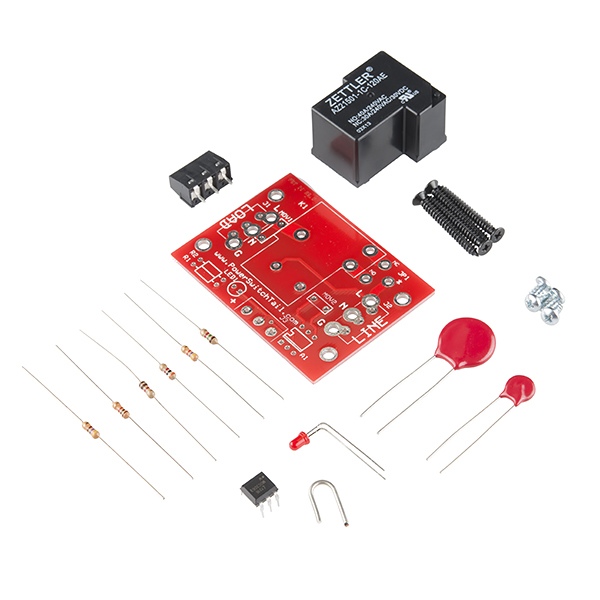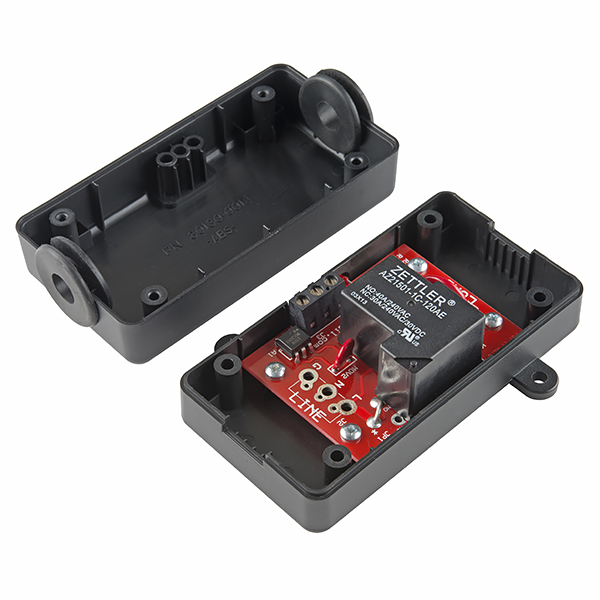PowerSwitch Tail Kit
Want to control a standard wall outlet device with your micro controller, but don't want to mess with the high voltage wiring? This might just be the right device for you!
The PowerSwitch Tail Kit is designed to allow you to safely control an outlet device without exposing any 120VAC voltages while being able to "customize" it to meet your applications needs. You can optimize the voltage required for the control signal by selecting and installing different resistor values for R1/R2 slots on the kit PCB. With this ability to choose the control signal voltage the PowerSwitch Tail Kit is given the ability to provide an input voltage from 3VDC all the way to 26VDC. Additionally, power cables are sold separately to give you the choice of cable you wish to use with this kit.
This variation of the PowerSwitch Tail is sold as an easy-to-assemble kit and includes everything listed below with clear assembly instructions listed in the documents section.
- 1x PowerSwitch Tail PCB
- 1x PowerSwitch Tail Enclosure (w/ Case and PCB Screws)
- 1x Relay (120VAC, 40A)
- 1x Red LED (3mm)
- 1x Metal Oxide Varistor 14mm (130V)
- 1x Metal Oxide Varistor 7mm (130V)
- 1x Resistor 1.0K ohm (1/4w)
- 1x Resistor 1.5K ohm (1/4w)
- 1x Resistor 4.7K ohm (1/4w)
- 1x Resistor 470 ohm (1/4w)
- 1x Resistor 1.1K ohm (1/4w)
- 1x Resistor 3.0K ohm (1/4w)
- 1x IC MOC3063
- 1x 3-Position Terminal Block (5.08mm)
- 2x Rubber Grommets
- Customizable control signal voltage
- 3VDC to 26VDC control signal range
- Drive directly from microcontroller pin with as little as 3VDC @ 3mA
- Connects directly to Arduino, Raspberry Pi, Beaglebone or other 3.3V or 5V MCU
- 20A switching capacity; 5300vrms isolation
- Two wire control signal; no separate DC power source required
- No exposed ac wiring
- LED status indicator
- [Instruction Sheet](https://cdn.sparkfun.com/datasheets/Components/General/PSTK Instructions R6A Oct 2013.pdf)
- Datasheets:
- Product Video
PowerSwitch Tail Kit Product Help and Resources
Core Skill: Soldering
This skill defines how difficult the soldering is on a particular product. It might be a couple simple solder joints, or require special reflow tools.
Skill Level: Rookie - The number of pins increases, and you will have to determine polarity of components and some of the components might be a bit trickier or close together. You might need solder wick or flux.
See all skill levels
Core Skill: DIY
Whether it's for assembling a kit, hacking an enclosure, or creating your own parts; the DIY skill is all about knowing how to use tools and the techniques associated with them.
Skill Level: Noob - Basic assembly is required. You may need to provide your own basic tools like a screwdriver, hammer or scissors. Power tools or custom parts are not required. Instructions will be included and easy to follow. Sewing may be required, but only with included patterns.
See all skill levels
Core Skill: Electrical Prototyping
If it requires power, you need to know how much, what all the pins do, and how to hook it up. You may need to reference datasheets, schematics, and know the ins and outs of electronics.
Skill Level: Competent - You will be required to reference a datasheet or schematic to know how to use a component. Your knowledge of a datasheet will only require basic features like power requirements, pinouts, or communications type. Also, you may need a power supply that?s greater than 12V or more than 1A worth of current.
See all skill levels
Comments
Looking for answers to technical questions?
We welcome your comments and suggestions below. However, if you are looking for solutions to technical questions please see our Technical Assistance page.
Customer Reviews
4.3 out of 5
Based on 3 ratings:
Great kit
Split a drop cord and wire it up. Have a Moray board controlling my de-humidifier in the basement when there's excess solar from my roof panels.
Great tool to have on hand
I originally used the PowerSwitch Tail to control my Solidoodle 2 printer with an OctoPi.. Since upgrading from the SD2, i've now used it for a few random tasks including switching Christmas lights off and on. A really great tool to have around!
Very nice product.
Easy to assemble. Works great. I am using it to switch about 17 Amps on and off with no problem. It's noisy but to be expected for a mechanical relay.





Now all we need is one that provides power for the MCU as well.
Will there be a 240v version of this kit? It seems only the movs and relay needs to be changed?
There is a 240V version I have purchased 2 and use them daily for the past year or so. They work well with an ATTiny chip driving them. See http://www.powerswitchtail.com/Pages/PSTKKit.aspx I don't know if Sparkfun carry the 240v version of the kit.
Is this UL listed? I assume not…
The LED Silkscreen on the board has the wrong polarity. The LED is prebent to correct way but, the silkscreen is showing the polarity reversed so I had my son look up the + leg of the LED and test it with a battery and bent it to correspond to the silk screen - Epic Fail! I now have to take it apart and fix it :(
IgnacioV: Per your question - Haute Solutions sells a complete kit with the enclosure and also includes a power supply for the MCU and a clear cover. One power cord into the enclosure and one (20A) power socket for your 120V device - thats it. User configurable MCU mounting plate, clear cover, and has enough room to add a shield of your choice. Also available as a pre-built item with a GSM/SMS arduino based board (and SIM card) already installed: http://www.haute-solutions.com/prod_maker.html
At that price? No thanks.
There are optional terminal blocks (J1 and J2) in the kit instructions for the 120 vac supply and load side but no part numbers or other details - does Sparkfun have these terminal blocks? Note that the kit says the maximum gauge wire for the terminal blocks OR the solder pads is 14 ga. solid wire.
Does this kit have a higher Max currently rating than the assembled one?
The kit and assembled versions appear to use the same parts. However if you build the kit with a 12ga power cord it should handle 20A.
Okay thank you, I was just curious as the assembled one says 15A only and this one says 20A, but the wiring gauge makes sense.